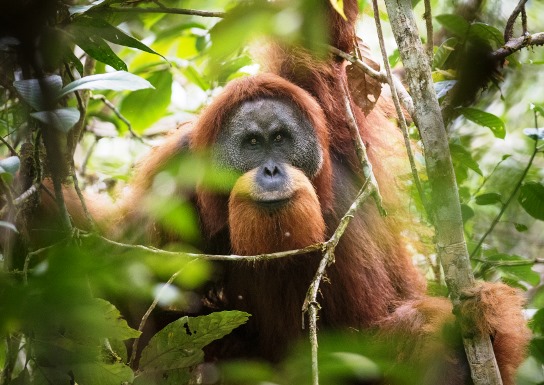A new species of orangutan has been identified in the Batang Toru forest ecosystem in northern Sumatra, Indonesia. Genetic and morphological evidence, as well as behavioral data, have confirmed that the Tapanuli orangutan (Pongo tapanuliensis) is different from the two other known species of orangutans—the Sumatran orangutan (Pongo abelii) and the Bornean orangutan (Pongo pygmaeus)—which are both critically threatened species. However, with an estimated 800 remaining individuals, the Tapanuli orangutan is now designated as critically endangered, thus making it the most endangered species of all great apes. The Tapanuli orangutan's survival is currently severely imperiled. See also: Animal evolution; Anthropology; Apes; Biogeography; East Indies; Endangered species; Forest ecosystem; Population ecology; Primates; Speciation; Systematics

In 1929, the bonobo (pygmy chimpanzee) was discovered and added to the great ape group, which includes the gorillas and chimpanzees of Africa and the orangutans of Asia (humans can be included in the great ape group as well). Since then, no other extant great ape species had been newly identified until now. Thus, the discovery of a new species of orangutan is quite a rare event; however, scientists are concerned that there may not be sufficient time to preserve and save this animal from extinction, especially as the forested areas in which it lives are not fully protected from human encroachment. For example, logging, mining, road construction, and damming of water sources are permitted in important parts of the Tapanuli orangutan's habitat, threatening this creature's existence. See also: Extinction; Population viability; Species concept
There had been reports in the 1930s indicating the possibility of a unique group of orangutans living in the Tapanuli foothill forests of Sumatra, but no follow-up research was undertaken at that time. However, in 2013, a skeleton of a dead orangutan from this area was found, and an examination revealed unusual anatomical features in the jaw and skull, as well as frizzier hair, which differentiated this ape from individuals belonging to the two other orangutan species. Additional studies were subsequently undertaken, including behavioral observations of the Tapanuli orangutans in the wild, as well as phylogenetic DNA-sequencing analyses of two captive animals. After comparison of the sequenced genomes of the Tapanuli orangutans to those of other Sumatran and Bornean apes, scientists concluded that the Tapanuli orangutans represented a new species, which split from the Sumatran orangutan species and the Bornean species approximately 3.4 million years ago and 674,000 years ago, respectively. Although interbreeding with the Sumatran orangutan did occur after the splitting of the lineages, the Tapanuli orangutan became completely isolated by 20,000 years ago. See also: Deoxyribonucleic acid (DNA); Island biogeography; Phylogenetics: predicting rarity and endangerment; Phylogeny; Population genetics; Zoogeography
Conservationists hope that news of the Tapanuli orangutan discovery will alert the world to the fragile existence of all the orangutans of Sumatra and Borneo. In particular, though, the forests of Batang Toru, comprising only 1100 square kilometers (425 square miles), are being highlighted as specific areas that must be preserved and protected for species conservation. Without quick action and strict enforcement, the habitat of the Tapanuli orangutan will dwindle in size, ultimately sealing the fate of this newly identified great ape. See also: Conservation (species); Environmental management; Forestry; Land-use planning





